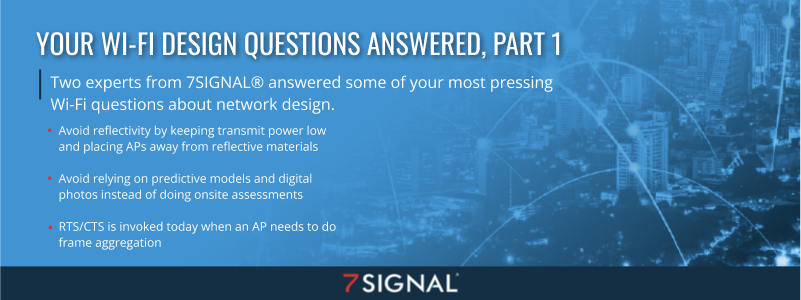
Blog
Two experts from 7SIGNAL® answered some of your most pressing Wi-Fi questions about network design.

Two Wi-Fi experts from the 7SIGNAL® team sat down to answer our audience’s most pressing questions about Wi-Fi design, from site surveys to reflective environments RTS/CTS. Learn what Vice President and Chief Wireless Officer Jim Vajda and Senior Sales Engineer Chris Couch had to say.
1. How should I design for a highly reflective environment?
First, you want to keep your transmit power low to reduce the effect of reflections that are occurring. You can also use directional antennas to focus the radio frequency (RF) away from reflective materials and toward the area where you need coverage.
Access point (AP) placement is a big factor as well. You don’t want to place your APs near areas where there is a lot of reflective material if you can avoid it. The closer they are, the higher the power is in those areas, and the worse the situation gets.
Also, consider how you’re placing your antennas – not only directionally, but try using a showerhead approach. In that approach, patch antennas are facing straight down from the ceiling.
Use clients and APs with multiple spatial streams, since multiple transmit and receive chains can help – not only because they can increase throughput but also because if one path has faded, another may work. You have some redundancy there. Even if you have APs with four spatial streams and don’t have clients with those four, when the AP is receiving, it will receive on all four radio chains and combine the signal to help overcome some challenges of reflectivity.
2. Should I rely on digital photos and a predictive survey instead of viewing AP mounting locations in person?
Relying only on a predictive survey creates additional operational work after the design to adjust it and keep a closer eye on it. And you also need to have some level of onsite validation, so predictive-only modeling isn’t an ideal approach.
You may know all about the construction materials and have already had some success there, but you still need onsite validation – not just to perform a site survey and measurements of RF, but also just to confirm more simple things. Did the installers place the AP where you told them to place it? Are they mixed up or in the wrong spots? Installers may swap a box or mislabel an access point. Or a radio may not be working, even though you see it online.
You can’t overcome those types of problems without going onsite. You need a visualization beyond digital photos.
3. What do you think of using the Aruba 635s in the office areas (not a shop floor office area) and the 515/514s in the shop/warehouse areas? Do you see the mixture as a concern as long as we aren’t mixing 635s with 514s in one area?
First, let’s point out that 515/514 are Aruba Access Points – 515 is an internal AP and 514 is external. 635 is the Wi-Fi 6E access point and is internal.
If the 635s are placed in office areas, you will have carpeted spaces with 6E access points and no external antennas, which will work well. Separating those from your warehouse areas is a great way to do it, as long as you’re not taking those 635s and putting them alongside the 500 series.
It’s not a big issue to have both internal and external APs in the same area. But you need to make sure to design to accommodate the antenna types.. Design to the capability of the AP you’re working with.
There isn’t any advantage to intermixing 6 GHz with 5 and 2.4 GHz when transitioning between radios in a warehouse or office. It’s best to avoid mixing the AP models in the same RF domain.
4. Can you replace an existing 5GHz-only network with a 5/6GHz network while replacing APs one-for-one?
You can do this, but it’s not advisable – we don’t recommend it. Although omnidirectional APs usually have similar coverage patterns from generation to generation, and you can work with the transmit power within the AP itself to overcome differences, that’s only when you’re doing like-for-like in 2.4 and 5 GHz coverage. With 6 GHz, the AP’s coverage cell is between 2 and 5 dB below what you get from 5 GHz, and some people have concluded that it’s not a big deal.
The problem is, with 6 GHz, the clients have a unique restriction. In the U.S., 6 GHz clients can only transmit at a maximum of 6 dB below the current transmit power of the AP. Clients aren’t in fixed locations, and some may be outdoors, so there could be a lot of clients and a lot of RF. It’s a protection mechanism for incumbents from Wi-Fi interference. The uplink performance may be much poorer for 6 GHz clients than for 5 GHz clients.
You should redesign and take that uplink performance into account with a higher density design for 6 GHz to perform well.
5. Is it wise to use a channel width of 320 MHz in Wi-Fi 6E?
This is only a Wi-Fi 7 feature. Wi-Fi 6E doesn’t support it, and it will pose problems in the future, too. In Europe, if you have 500 MHz of spectrum and you’re using a 320 MHz-wide channel, you have one non-overlapping channel.
If you’re in your house, you have no neighbors, and the APs and clients can support this, then maybe. But you should stay away from this, depending on where you are. It’s counterproductive, and stations would have to do clear channel assessment (CCA) across all 16 subchannels to make sure there’s nothing going on there before transmitting. You may run into channel access issues, and there’s no real-world use case for it.
6. Under what circumstances is RTS/CTS invoked? Is it initiated from the client, infrastructure, or either? If I see RTS/CTS frames, does it always mean the airtime is congested?
The first part of this question has a long answer. There are several circumstances when RTS/CTS is invoked, and it’s changed over the years. The first purpose of this was to address hidden notes. For example, if you have two distant clients who can’t hear each other and they’re talking to the same AP, they’ll transmit on top of each other, and the AP receives both signals at the same time. This leads to corruption, but the clients don’t understand why that’s happening because they can’t hear each other.
You used to be able to go into the clients and turn on RTS/CTS to prevent that from being a problem. One client would send a request to send frame (RTS) to the AP, the AP would respond with a clear to send frame (CTS), and all other clients would hear the CTS and back off so the original can send that frame. The hidden note problem was thus addressed.
Then, RTS/CTS started to get a bad rap. It was used as a protection mechanism for backward compatibility in 802.11b and 802.11g. Those are generations of Wi-Fi that operate at 2.4 GHz, along with 802.11n, and to gain channel access, the newer stations had to use RTS/CTS to set the NAV timer on those 802.11b/g clients. In some cases, they had to send it at 1 megabit per second with the old 802.11b preamble. You lost a significant amount of airtime doing that, and that’s when it became a network design consideration to disable RTS/CTS. You won back airtime this way, but broke backward compatibility with legacy stations on the channel.
The airtime consumption of RTS/CTS frames is much smaller today – a quarter of what it used to be because they are OFDM formatted in 5 and 6 GHz. There are new circumstances where RTS/CTS is required as well. A client or AP that needs to do frame aggregation will start with an RTS/CTS exchange to reserve a transmit opportunity (TXOP). Then, everyone knows one station gets to transmit.
Additionally, RTS/CTS is required when using channel widths of 40 MHz or greater, which is more and more common.
Also, 802.11ax has a duration-based RTS/CTS feature, where you can set a threshold on the AP in time and duration, which triggers the requirement for RTS/CTS.
As to the last two parts of this question: If you see these types of frames, it suggests that RTS/CTS is in use, but the channel is not necessarily congested. The client or the AP could be initiating this, and both can decide when to use it.
Learn more from the 7SIGNAL experts
We’re always here to answer your Wi-Fi questions at 7SIGNAL. Our wireless experience monitoring platform and Mobile Eye® and Sapphire Eye® sensors help you plan and execute a healthier network. Contact us to learn more.
7SIGNAL® is the leader in wireless experience monitoring, providing insight into wireless networks and control over Wi-Fi performance so businesses and organizations can thrive. Our cloud-based wireless network monitoring platform continually tests and measures Wi-Fi performance at the edges of the network, enabling fast solutions to digital experience issues and stronger connections for mission-critical users, devices, and applications. Learn more at www.7signal.com.